Trikonasana (Triangle Pose): Health Benefits,steps,Types & variations
What is the Trikonasana yoga pose?
Trikona – Triangle; Asana – Pose
This asana is pronounced as Tree-Kone-Nah -sah-Nah (Trikonasana). The word ‘Trikonasana’ arrives in the Sanskrit words, ‘Trikona’ meaning three corners, and ‘Asana’ refers to posture. In trikonasana yoga, the person straights their legs apart without bending the knees, wherein hands spread apart, creating an angle of 90 degrees between the upper and the lower part of the body. Unlike most yoga postures, the Triangle Pose needs to keep the eyes open in order to maintain body balance.
Trikonasana, also known as the triangle pose, is a basic standing pose in yoga that strengthens and lengthens the groin and hamstrings while also opening the shoulders and stretching the hips. The primary posture is named for the triangle shape your body makes as you bring your bottom hand to the ground and keep your feet grounded during the move. There are many variations in trikonasana steps or the method of trikonasana. Generally, its three types include Baddha Trikonasana, Utthita Trikonasana, Parivrtta Trikonasana.
What are the Health Benefits of Trikonasana (Triangle Pose)?
By practising Trikonasana daily, you can aid the following benefits –
The physical benefit of doing Trikonasana
- This exercise assists to strengthen and stretches the legs.
- Trikonasana stretches the spine and hip and improves flexibility.
- Open up the chest and shoulders.
- It Stretches spinal muscles and improves the spinal range of motion.
- Triangle Pose aids to increases neck mobility.
- It aids the body to inhale fresh oxygen and nutrients.
- Strengthens and Tones the muscles of the thighs.
- Aids to relieve upper back tension.
- Stretches hamstrings, calf muscles, and hip muscles.
- Boosts the sense of balance by keeping the feet and ankles in space.
The Mental benefit of doing Trikonasana
- Improves mental and physical stability.
- Trikonasana aids to stimulate all the abdominal organs and boosts digestion.
- Relieves stress and cures anxiety.
What are the Preparatory poses for Trikonasana?
- Katichakrasana
- Vrikshasana
- Konasana
How to Perform Trikonasana?
Stand straight. Separate your feet comfortably around 4 feet wide apart.
Turn your left foot out 90 degrees and right foot in by 15 degrees.
Now align the center of your left heel with the center of the arch of your right foot.
Ensure that your feet are pressing the floor and the weight of your body is equally balanced on both feet.
Inhale deeply and as you exhale, bend your body to the left, downward from the hips, keeping the waist erect, allowing your right hand to come up in the air while your left hand comes down towards the ground. Keep both arms in a straight line.
Rest your left hand on your shin, ankle, or the ground outside your left foot, whatever is possible without distorting the sides of the waist.
Stretch your right arm toward the roof, in line with the tops of your shoulders. Keep your head in a neutral position or turn it to the right, eyes gazing softly at the right palm.
Ascertain that your body is bent sideways and not forward or backward. Chest and Pelvis are wide open.
Stretch maximum and be stable. Continue taking in long deep breaths. With each breathes out, relax the body more and more. Just be with the breath and the body.
As you breathe in, come up, draw your arms down to your sides, and straighten your feet.
Repeat the same on the other side.
How to do Triangle Pose by watching a video?
What are the Tips for practicing Trikonasana?
Make sure you have done a good warm-up exercise of the entire body before you perform the asana.
While bending forward perform it slowly and gently so as not to lose balance.
What are Follow up poses for Trikonasana?
- Virabhadrasana
What are the Types of Triangle Pose?
If you’re looking to change up your Trikonasana, there are some Types you can make, such as:
- UtthitaTrikonasana (Extended Triangle Pose)
- Parivritta Trikonasana (Revolved Trikonasana, or Revolved Triangle)
- Baddha Trikonasana (bound triangle pose)
- Baddha Parivritta Trikonasana (bound revolved triangle pose)
- Supta Parivritta Trikonasana (reclining revolved triangle pose)
- Bikram’s Triangle or Trikonasana
- Supta parivrtta trikonasana
- Supta utthita trikonasana
UtthitaTrikonasana (Extended Triangle Pose)
What is UtthitaTrikonasana?
Triangle Pose (Utthita Trikonasana) is a basic yoga pose across almost every different style of yoga. Triangle Pose’s relatively simple set-up contradicts its power as a stretch for the hamstrings. Establishing the basics of the pose with grounded feet and strong legs permit the chest to twist deeply and blossom open.
The extended Trikonasana or extended triangle pose (Utthita Trikonasana) needs nearly the same setup and execution as the regular Trikonasana, except the stance, is wider to open the pelvis, and the hand placement varies slightly. For instance, if you’re reaching your right foot with your right hand, grasp your big toe or place your lower hand flat on the floor beside the foot, rather than stopping at the shin or ankle.
Utthita Trikonasana can give you a healthy mix of landed stability and heart-opening expansion of the chest. It stretches the hamstrings and back muscles while stimulating the abdominal muscles. This pose needs concentration and steady breath, which can aid focus a wandering mind and bring you completely to the present moment.
When you’re undertaking the somewhat challenging, yet deeply advantageous, Extended Triangle Pose, it aids to remember that the pose is actually a representation of its title: In it, your body creates various-sized triangles. Think of the angles made by your legs and the ground; the small triangle between your arm, front leg, and upper body; and the large angle made by your side body with the mat and front arm.
Utthita Trikonasana Benefits (Extended Triangle Pose):
- The Utthita trikonasana advantages the hip region.
- This trikonasana yoga is also boon for the spine.
- It aids in stretching and strengthening ankles, knees, thighs, and torso.
- It also improves digestion while stimulating abdominal organs.
Preparatory poses for UtthitaTrikonasana:
- Ardha Uttanasana (Standing Half Forward Bend)
- Parsvottanasana (Intense Side Stretch Pose)
- Virabhadrasana II (Warrior II)
- Prasarita Padottanasana (Wide-Legged Forward Bend)
How to do Utthita Trikonasana?
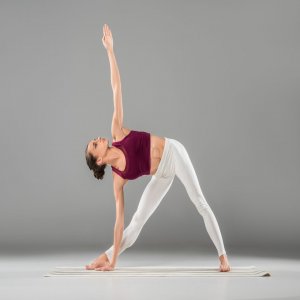
Engage your left thigh muscles and draw your left femur into its socket. Extend your left hand toward the front of the room, keeping your left hip tucked.
Lower your left hand down, onto your shin or ankle. If you are more open, bring your left hand to the ground on the inside or on the left foot. Do whichever one feels most comfortable.
The right shoulder stacks on top of the left one as you open your chest, reaching your right fingertips toward the ceiling while maintaining your right shoulder rooted in its socket.
Turn your head to take your gaze up toward your right fingertips. If this is problematic for your neck, it’s also fine to keep the head in a more normal position.
Continue to draw your left thigh muscles upward, deepening the crease in your left hip.
Soften your left knee slightly to prevent hyper extension. (This is called a micro bend.)
Hold for at least 5 breaths.
Repeat the pose with your right leg forward.
Counter poses for UtthitaTrikonasana :
- Uttanasana (Standing Forward Bend)
- Anjaneyasana (High Lunge)
- Viparita Virabhadrasana (Reverse Warrior)
- Paschimottanasana (Seated Forward Bend)
Beginner’s Tip for UtthitaTrikonasana:
- If your legs are too close together, you won’t feel the full advantage of the pose. The distance you need between your feet are unique to you and the length of your legs, but make the stance as wide as possible while still keeping stability.
- You shouldn’t feel strained, but rather a satisfying stretch.
- Be sure to roll your front thigh outward to keep your knee aligned with your foot.
- Avoid spreading out your hips, locking out your knees, or tightening your shoulders up to your ears in this pose.
Variation for Extended Triangle with a block :
If you can’t reach the ground without twisting or rounding your back, put a block beneath your shoulder inside your front ankle. Alter the height of the block to whatever level feels comfortable for you.
Common Mistakes during UtthitaTrikonasana:
- Resist the temptation to bend your left knee in order to get your left hand to the floor. Keeping your left leg straight is more important. Placing a block on the ground under your hand is also an option.
- Do not place your hand directly on your knee as this puts too much pressure on the joint. Also, make sure the left heel is in line with the arch of the right foot.
Safety and Precautions during UtthitaTrikonasana:
- Prevent this pose if you have an injury to your back, neck, hips, or shoulders.
- You may also wish to prevent it if you have diarrhea, headache or migraine, are pregnant or have low or high blood pressure.
- Consult your doctor to learn if Triangle Pose is safe for you.
Parivritta Trikonasana (Revolved Trikonasana, or Revolved Triangle)
What Is Parivrtta Trikonasana?
Trikonasana has one common alternative, Parivritta Trikonasana (revolved triangle pose). Where in Utthita Trikonasana (with the right foot forward) the right-hand reaches down towards the right foot, in the revolved pose it is the left-hand reaches to the right foot and the trunk is rotated strongly to make this possible.
Parivrtta Trikonasana, or revolved triangle pose, is a yoga pose grounded on a triangle pose. Revolved triangle is best for either beginner or a more advanced yogi, and can boon both your physical and mental health.
Benefits of Parivrtta Trikonasana (Revolved Triangle Pose):
- Tones strengthen and stretch the muscles of the hamstring, glutes, calves, quadriceps, and knees.
- Massages the pelvic region and reproductive organs of the body.
- Gives an intense stretch to the spine and improves its flexibility. Strengthens spinal nerves.
- Decreases the stiffness of the neck and is advantageous in correcting the misalignment of the shoulders.
- Passes the blood flow in the lower region of the spine improving its functioning.
- Braces’ abdominal organs are hence helpful in removing digestive problems and constipation.
- Helpful in reducing anxiety as it activates the whole functioning of the nervous system.
- Improves stability. Parivrtta Trikonasana stimulates your core muscles, which helps in balance and stability.
Preparatory poses Parivrtta Trikonasana:
- Bharadvajasana (Bharadvaja’s Twist)
- Utthita Trikonasana (Extended Triangle Pose)
- Parsvottanasana (Intense Side Stretch Pose)
- Virabhadrasana I (Warrior I)
- Uttanasana (Standing Forward Bend)
How to Do Parivrtta Trikonasana:
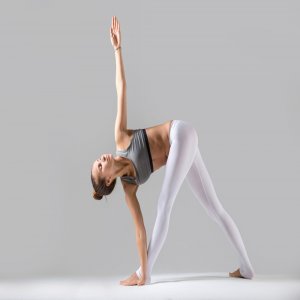
Position your body. beginning in the mountain pose (or Tadasana), move your feet to around four feet apart, and extend your arms, so they’re parallel to the floor with your palms facing down. If you’re starting on the left side, the left the foot should be at a 90-degree angle with the end of the mat, with your right foot at a 45-degree angle.
Flex to the side. Take a deep breath, then exhale as you flex your body at the hip joint, extending to the side over the left leg (if you’re starting on the left). Keep the sides of your waist straight, not scrunched. straighten your tailbone towards your back heel.
Reach with your arms. As you reach your right arm down to your left foot (or your left arm down to your right foot if you have your right foot forward). Gently grasp your ankle or your big toe with the hand reaching to the floor. At the same, put your other hand on your hips. If you want to take the pose a bit further, you can extend your opposite arm up toward the roof or sky.
Hold and repeat. With your shoulders aligned, turn your head and look up to the roof. Briefly hold, then return to the starting position and repeat with the opposite leg.
Follow-up poses Parivrtta Trikonasana:
- Uttanasana (Standing Forward Bend)
Tips for Performing Parivrtta Trikonasana:
Before doing any new exercise, consult your doctor to determine if it’s right for you. Parivrtta Trikonasana may seem simple, but it can be less effective when done incorrectly. To successfully perform a triangle pose, check out the following tips:
- Keep your legs extended. If you’re moving towards your foot but can’t quite get there, avoid flexing your knee, which can make the pose less productive. If knee-bending continues to be a problem, place a yoga block beside your straight leg to use for leverage.
- Avoid flexing your back. Parivrtta Trikonasana is not a forward flex but a sideways motion at the hips performed with straight arms and legs. Avoid flexing your back and rounding your spine while doing a triangle pose. Your body should create the shape of the letter “I” rather than “C.”
- Engage your muscles. While this pose may seem simple to perform, it does need the active engagement of your core and thighs to be effective. As you sink into the basic pose, keep those muscles tightened to receive all of the advantageous.
Variation of Revolved Triangle Pose with a block:
Follow the directions above, but draw your hand to a block at any height rather than the ground. If you do not have a block, you can draw your hand up higher on your shin rather than on the ground.
Common Mistakes during Parivrtta Trikonasana practice:
You’re Raising Your Heel
As you’re getting a feel for the Revolved Triangle pose, a regular mistake you’re likely to make is letting your heel come up from the floor. Keeping your feet grounded throughout the motion isn’t just about staying focused and mentally centred during your yoga practice; it will actually shake off your balance and make it more likely you’ll strain or injure yourself. One of the easiest fixes if you’re having this problem is to practice the pose with your heel against a wall.
You’re Forcing the Twist
While the basic move of the pose is twisting your torso, you may be demanding more than your body is ready for if you feel pain. While some physical elements will limit how far you’re able to twist, the position may also feel easier as your the body becomes more conditioned.
Whether you’re practicing the move for the first time or using it as part of established yoga practice, it’s essential that you stay focused and go slowly.
You’re Holding Your Breath
In addition to making sure your muscles have the oxygen, they require to move and stretch with you, paying attention to your breathing also slows you down (which aids prevent injury) and hones your focus. If you’re having a hard time finding your breathing pattern, your yoga instructor can give you awareness exercises to assist.
You’re Not Keeping Your Head in Alignment
One mistake you might not even notice you’re making is allowing your head to get out of alignment. If you let your head stand out beyond your front leg, it will shake off your balance and can cause back strain. When you’re learning actually form, it can be helpful to have a yoga classmate or instructor nearby to give guidance and feedback.
Safety and Precautions of Parivrtta Trikonasana:
Reversed triangles and other twisting poses can be challenging, so you need to check in with your instructor before Try them on your own.
As with any type of physical activity, it’s best to check in with your doctor before beginning or intensifying a routine. Twisting poses like Reversed Triangle may be unsafe for people with some diseases, injuries, or those recovering from surgery.
Contraindication for Parivrtta Trikonasana:
- Deep twisting is not suggested during pregnancy.
- Have lower back, neck, or sacroiliac pain.
- Have conditions affecting your back or spine, such as bulging or herniated discs.
- Have recently had surgery or an injury including your neck or back
- Have low blood pressure (hypo tension).
- If you attend a daily yoga class, your instructor may also advise students to prevent Reversed triangles or another twisting poses when you’re feeling insomnia, headaches or migraines, or gastrointestinal distress.
Baddha Trikonasana (bound triangle pose)
What is Baddha Trikonasana (Bound Triangle Pose)?
The bound triangle pose is an alternative to Trikonasana, as yogis extend their torsos beyond to permit them to take their hands around for binding. The main components of mastering baddha trikonasana are the contractions of the abdominal muscles and the stretch of the hamstring of the straight leg. Bound yoga poses helps in improving the the flexibility of the hips and arms. In addition, they help in stretching the muscles of the diaphragm, and the activation of internal organs.
Baddha Trikonasana Benefits:
The practise of Baddha Trikonasana gets the same benefits as in Utthita Trikonasana and Ardha Baddha Trikonasana, but along with these advantages, the additional advantages derived with the arms bound are explained below:
- Stretches, Strengthens, Lengthens: Binding is a modern way to deepen the practice and in Baddha Trikonasana, the side upper body goes in a deeper stretch keeping the rest of the active muscles of the lower back, neck, hips, shoulders, and legs in a deep stretch too. This further aids to lengthen these muscles making them strong and flexible.
- Chest, Diaphragm and Breath: The interlocking of the arms behind the legs and hips comes with the deep stretching of the shoulders, upper back, and chest hence opening the chest. With the opening of the chest, the intercostal muscles get space to dilate more, and with the maximum use of the diaphragm and the chest muscles, deep breathing is uplifted. This activates the heart and the lungs and is a great way to activate the Heart Chakra.
- Circulation and Systems: The improved range of motion due to the binding of hands behind keeps them involved muscles are active, flexible, strong, and support the respective organs. These organs get stimulated and do function well with the increased blood circulation. The lateral fold with the twist in the upper and middle back is good for muscles which ultimately advantages the organs.
- Others: The practice of Bound Triangle Pose is not just about improving flexibility, but it is more about doing it with a holistic approach. Deepening a yoga pose is a great way to connect within, by understanding the body and breath motions. With deep practice, there is better stability which helps to practice modern yoga poses or just to build sthiram in the practice.
- Preparatory Pose: When the torso goes in a side fold with a twist, the muscles involved at the abdomen, spine, arms, shoulders, legs, and chest work harder to help move the torso. This raises strength in the active muscles to follow deeper bound hands practices and stretches like Revolved Wide Angle Forward Bend, Baddha Ardha Chandrasana, Garudasana, or Fallen Triangle.
Steps for baddha trikonasana:

Start from the lunge position.
Draw the back heel downwards and turn your foot 30 degrees inwards.
Now, place both of your hands on the ground—this should be inside your front foot.
Breathe in completely. Breathe out, and bend your torso inside your front thigh.
Using your left hand, hold your left calf’s back.
Bring your left shoulder beneath your left thigh, and the top of your shoulder to the back of the calf.
Place your left hand’s back in the outer part of your left hip.
Swing up your right arm, and hold the right wrist behind your torso using your left hand.
Rotate your right shoulder over your left shoulder. Face down.
Straighten your left leg.
Raise your torso to be in a parallel position with the ground—press your knee into your hand, and your hand into the knee, so that your knee and upper body isometrically move in reverse directions.
Turn your ribs and abdomen upwards. Face up, hold your breath and posture.
To release, face down. flex your front knee. let go of the bind and put your hand on any side of your foot.
Repeat on the opposite side.
Baddha Parivritta Trikonasana (bound revolved triangle pose)
What is Baddha Parivritta Trikonasana ?
This looks like Parivritta Trikonasana but is bound with the hands joined, in the same way, that Baddha Trikonasana is for unrotated (Utthita) Trikonasana.
How to do Parivrtta Baddha Trikonasana:
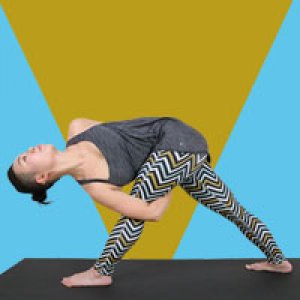
Start from the lunge pose. Now, hold your upper thigh with your left hand—your thumb should be on the middle of your thigh, and your fingers on your outer quads.
Breathe in and raise your torso and your right hand vertical.
Now, breathe out, twist your torso to the left and then place your right shoulder on your outer-left knee.
Bring your left hand to your left hip’s crease. Now, pull your left hip backwards and down.
Now, swing your right hand underneath your left thigh and your left hand behind your back. Hold your left wrist using your right arm or vice versa.
While facing down, slightly step your back foot forward. move your back heel down, and then turn the foot 60-degrees.
Move your left hip backwards until your thigh is in an aligned position to your mat’s long edge.
Keep your front leg straight.
Turn your ribs and abdomen upwards, and rotate your left shoulder over your right shoulder.
Face up. Hold the posture and then breathe.
To release, look downwards, flex your front knee and release your hands to any side of your left foot. Step your left foot backwards and then raise your back heel.
Repeat the same sequences on the other side.
Supta Parivritta Trikonasana (reclining revolved triangle pose)
Supta (Utthita) Trikonasana (reclining triangle pose) has the body, arms, and legs arranged exactly as for standing(Utthita) Trikonasana, but lying on the ground. It is suitable to have the feet pressing on a wall, with the yoga mat align to the wall and a small distance from it.
Bikram’s Triangle (Trikanasana)
What is Bikram’s Triangle?
The Bikram triangle pose needs open and strong hips. At first, the posture can be extraordinarily challenging, particularly as you continue gaining strength in your lower body. The intensity in your hips and legs can easily overwhelm you, but you need to keep your focus on the connection of your straight leg and spine. You can even achieve the straight line, even when your knees are not flexed so deeply. In addition, assure that your abdomen is straight and firm as possible. Then, ensure that your hips are open, and not twisted.
Benefits of Bikram’s Triangle:
- This posture aids in building strength in your hips and stretching them.
- It strengthens your legs and stretches your chest.
- It aids in boosting your focus and confidence.
How to do Bikrams Triangle Pose:
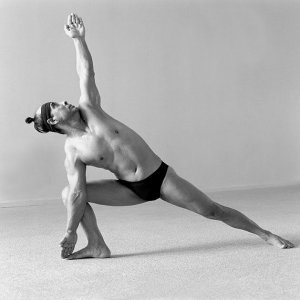
Begin in while you are still, and stand with your hands by your sides and feet together.
As you breathe in, extend your arms overhead.
As exhale, take a step to your left side—probably 2-3 feet.
Ensure that your hands are in a parallel position to the floor—sideways.
Now, turn your left foot outwards, and make sure that your hips are facing forward as much as you can.
Bend your left knee 90-degrees— your knee should be directly over your ankle. Your upper body should remain straight and your right hip as back as possible. Now, turn the palms to face forward.
Bring down your torso. Your left hand should brush your left big toe, and your right arm should be straight up. Your chin should be facing your right shoulder. Now face upwards, stay in the pose and count to 10.
Turn your head forward, and bring your upper body upright. Ensure that your hands are in aligned with the floor—sideways.
Straighten your left leg, and turn your toes to face forward.
Turn your right foot outward, and ensure that your hips are facing forward.
Bend your right knee 90-degrees—the knee should be directly over your ankle. Your upper body should remain upright, and your left hip back. Now, turn your palms to face forward.
Bring down your upper body. Your left hand should brush your right big toe, and your right arm should be straight up toward the roof. Your chin should be facing the left shoulder. Now, face upwards, hold the position and count to 10.
Turn your head forward, and bring your upper body upright. Ensure that your arms are in aligned with the floor—sideways. Straighten your right leg and turn your toes to face forward.
As you inhale, bring your feet together, and extend your hands overhead.
Exhale and lower your hands to the side. Remain still.
What to Keep in Mind for Trikonasana (Triangle Pose)?
One should keep these things in mind to acquire maximum benefits of trikonasana:
Keep the legs straight
Initially, it is very tough to touch your foot with your hand. At this time, one should avoid flexing their knees. If the knee bending problem continues, use a yoga block as leverage.
Keep your muscles engaged
It may look simple to perform trikonasana yoga. However, without the active muscle engagement of the core and thighs, one may fail to procure trikonasana advantages.
Avoid bending the back
This exercise is a sideways motion or body bending exercise. Hence, one should avoid folding the back or rounding the spine while doing this.
Avoid chest rolling towards the ground. Instead, roll your shoulders back and raise the chest away from the front thigh.
Do an ample amount of warm-up exercise before performing trikonasana.
Flex your body slowly and gently for better balancing.
What are Precautions for Triangle pose?
- This asana shouldn’t be done who have severe back pain.
- Don’t perform this yoga who is suffering from migraines.
- A person who is detected with diarrhea, neck & back injuries, and high blood pressure, shouldn’t perform this asana.
- Those who are experiencing dizziness shouldn’t look down at the ground during the final stage.
- Cervical spondylosis should perform with proper precautions.
- Don’t take the support of your knee while doing this asana as it transfers excess pressure on your knee that may lead to knee issues.
- Having neck problems, don’t look up while doing this asana. It is better to gaze straight or look down at the ground.

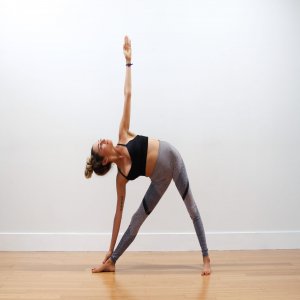
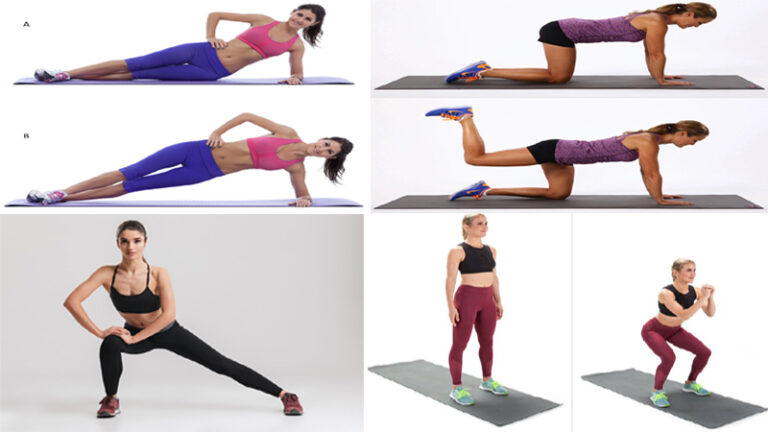
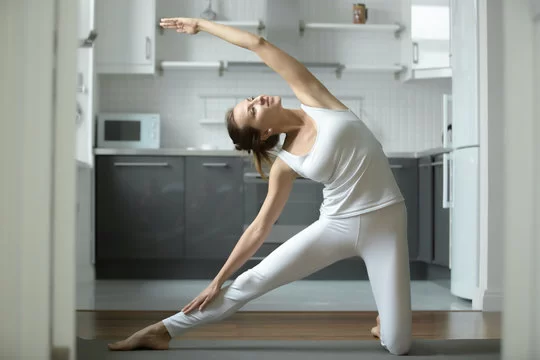
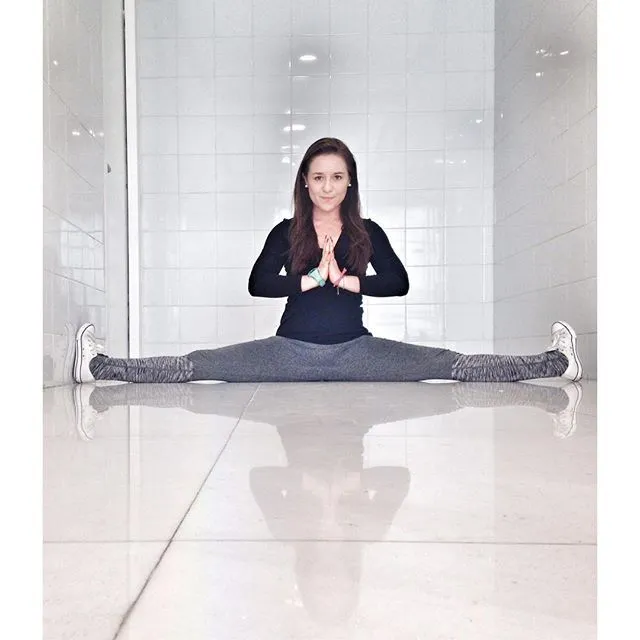

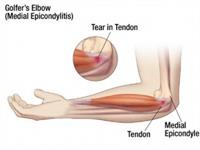
One Comment